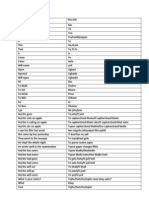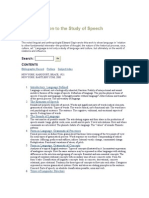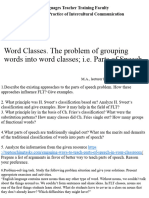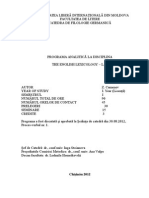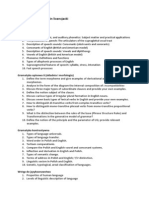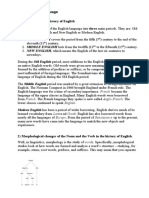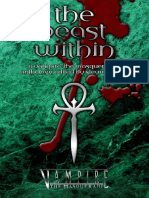Filologie Engleza
Filologie Engleza
Uploaded by
Alexandrina BarajinCopyright:
Available Formats
Filologie Engleza
Filologie Engleza
Uploaded by
Alexandrina BarajinOriginal Title
Copyright
Available Formats
Share this document
Did you find this document useful?
Is this content inappropriate?
Copyright:
Available Formats
Filologie Engleza
Filologie Engleza
Uploaded by
Alexandrina BarajinCopyright:
Available Formats
Moldova State University English Philology Chair Master Degree 2010 admittance examination program: I.Stylistics.
Expressive Means (EM) and Stylistic Devices (SD). Some Notes on the Problem of the English Literary Language (Standard English). A Brief Outline of the Development of the English Literary Language. Varieties of Languages. Types of Lexical Meaning. Stylistic Classification of the English Vocabulary. Neutral, Common Literary and Common Colloquial Vocabulary. Special Literary Vocabulary. Special Colloquial Vocabulary. Phonetic Expressive Means and Stylistic Devices. Lexical Expressive Means and Stylistic Devices. Intentional Mixing of the Stylistic Aspect of Words. Interaction of Different Types of Lexical Meaning. Interaction of Dictionary and Contextual Logical Meanings. Interaction of Primary and Derivative Logical Meanings. Interaction of Logical and Emotive Meanings. Interaction of Logical and Nominal Meanings. Intensification of a Certain Feature of a Thing or Phenomenon. Peculiar Use of Set Expressions. Syntactic Expressive Means and Stylistic Devices. Problems Concerning the Composition of Spans of Utterance Wider Than the Sentence. Particular Ways of Combining Parts of the Utterance. Peculiar Use of Colloquial Constructions. Transferred Use of Structural Meaning. Stylistic and Grammatical Morphology. Guide to Lexico-Syntactical Stylistic Devices. Functional Styles of the English Language. The Belles-Lettres Style. Language of Poetry. Emotive Prose. Language of the Drama. Publicistic Style. Oratory and Speeches. The Essay. Articles. Newspaper Style. Brief News Items. The Headline. Advertisments and Announcements. The Editorial. Scientific Prose Style. The Style of Official Documents. II.Lexicology The Object of Lexicology. The Connection of Lexicology with Phonetics. Stylistics, History of the Language and Grammar. Lexicology and Sociolinguistics. The Sociolinguistic Process of Borrowing into the British Variant of English. The Sociolinguistic Process of Borrowing into the American Variant of English. Lexicology and Suprasegmental Phonology. Lexicological Phonetics. The Prosody of Enantiosemy. Word Meaning. Types of Meaning. Word Meaning and Meaning in Morphemes. Word Meaning and Motivation. Change of Meaning. Meaning and Polysemy. Polysemy and Homonymy. Word Meaning in Syntagmatics and Paradigmatics. Meaning Relations in Paradigmatics and Semantic Classification of Words. Antonyms. Synonymy. Word-Groups and Phraseological Units. Some Basic Features of Word Groups. Structure of Word Groups. Meaning of Word Groups. Independence of Structure and Meaning in Word-Groups. Word-Building. Affixation. Conversion. Compounding. Abbreviation, Clipping, Blending. Some of the Minor Types of Modern Word-building. Phraseology. Phraseological Units (Set Expressions. Stylistics of the Word. Stylistics of the Words. The Etymology of the English Vocabulary. Borrowings.
Interrelations Between Native and Borrowed Elements. The Enrichment (Replenishment) of the English Word-Stock. Ways and Means of Enriching the Word Stock. Variants and Dialects of the English Language. The Main Variants of the English Language. The British and the American English Variants. Archaic Words. Neologisms. English Lexicography. Types of Dictionaries. Terminology. Additional materials. The Sociolinguistic Process of Borrowing. The Formation of the International Vocabulary. The Sociolinguistic Motivation of the Vocabulary. The Basic Metalanguage of Lexicology. III. Practical Phonetics. Classification of phonemes in English. The system of phonemes in English. The Systgem of vowels and consonants in English. Weak and strong forms of phonemes. Word stress, sentence stress, primary and secondary stress. Tone, tempo, pause. IV.Practical Grammar. Morphology. The system of verbal categories in English: tense, mood, voice, anteriority (perfect forms), aspect (continuous forms), person and number. The Adjective: morphological and syntactic functions. The degrees of comparison of adjectives. The Adverb: morphological and syntactic functions: Degrees of comparison of adverbs. The Pronoun. Classification of pronouns. Personal and possessive pronouns. Syntax. Simple and compound sentences. Parts of the sentence. Subject and predicate, Object and adverbial modifiers. Prepositions and their classification according to their structure and type of communication. Classification of prepositions. The article: definite, indefinite and zero articles. V. History of the Language. Old English. The Old English verbal categories. The phonemes, development of monophthongs and diphthongs. Parts of speech. Grammatical categories. Declension of nouns. The pronoun, adjective and grammatical categoies. Weak and strong verbs. Wordbuilding and structure of words. Middle English. The influence of the Norman Conquest on the development of the English Language. The London Dialect. Registered writings. The development of the national literary language. Modern Engllish and the progress of culture. Expansion of England. Renaissance literature. Change of orthography and evolution of sounds from 11th century up the the 18th century. Evolution of vowels and consonants. Changes in all the parts of speech: article, adjective, verb. Simplification of verbal conjugation. Morphological changes of the verb. Development of new forms and categories. Development of the English vocabulary. Patterns of Examination Questions: 1.The Connection of Lexicology with Stylistics 2.The Etymology of the English Vocabulary. 3. Stylistic Classification of the English Vocabulary. 4.Peculiarities of Literary, Neutral and Colloquial Layers of the English Vocabulary. 5.Phraseological Units (set-expressions) and Their Classification. 6. The Connection of Lexicology with the History of the Language. 7. The Evolution of the English Vocabulary. 8. Lexical Expressive Means and Stylistic Devices. 9. Syntactic Expressive Means and Stylistic Devices.
10. Lexical Expressive Mans and Stylistic Devices. 11. Morphological and Phonetic Expressive Mans and Stylistic Devices. 12. The Connection of Lexicology with Social Linguistics. 13 The Connection of Lexicology with Grammar. 14.The Connection of Lexicology with Phonology. 15. The Non Finite Forms in Modern English. 16. The Category of Aspect in Modern English. 17. Continuous/Non-Continuous or Perfect/Continuous Aspectual opposition. 18.The Category of Mood in Modern English. 19.The Category of Voice in Modern English. 20. Conditional and Subjunctive II in Modern English. 21.Subjunctive I and Suppositional II in Modern English. 22. Old English Verbal Categories. Bibliography: Akhmanova O. , L,Minaieva. An Outline of English Phonetics. M.,1973. Arnold I.V. The English Word. M., 1986. Blokh M. A Course in Theoretical English Grammar. M., 1983. Galperin I.R. Stylistics. M., 1971. Koonin A.V. . . 2005. Mednikova E.M. Seminars in English Lexicology. M., 1978. Melenciuc D. (alctuitor) A Reader in English Lexicology, MSU, 2005. Melenciuc D. (alctuitor) A Reader in English Phonetics, MSU, 2005. Melenciuc D. (alctuitor) A Reader in English Stylistics, MSU, 2005. Melenciuc D. (alctuitor) A Reader in the History of the English Language and Germanic Philology, MSU, 2005. Melenciuc D. Comparativistics. MSU, 2002. Rastorguyeva N.A. History of the English Language. M., 1969, 1983.
You might also like
- From Word to Sentence: A Guide to Grammar, Usage, and Sentence StyleFrom EverandFrom Word to Sentence: A Guide to Grammar, Usage, and Sentence StyleNo ratings yet
- Jorge Luis Borges Book of Imaginary BeingsDocument28 pagesJorge Luis Borges Book of Imaginary BeingsVinko SaravanjaNo ratings yet
- LexicologyDocument151 pagesLexicologyAlina CLNo ratings yet
- Jock Mackenzie-Essay Writing - Teaching The Basics From The Ground Up-Pembroke Publishers (2007) PDFDocument95 pagesJock Mackenzie-Essay Writing - Teaching The Basics From The Ground Up-Pembroke Publishers (2007) PDFDaniel100% (2)
- Bass Hanon 75 Exercises To Build Endurance and Flexibility For Bass Guitar Players by Scott Barnard PDFDocument7 pagesBass Hanon 75 Exercises To Build Endurance and Flexibility For Bass Guitar Players by Scott Barnard PDFLamy houlou Georges0% (1)
- Basic Conversation MarathiDocument3 pagesBasic Conversation MarathiGuruprasad Kanitkar0% (1)
- Paper 1 Year 5 KSSRDocument14 pagesPaper 1 Year 5 KSSRteacher_sri1No ratings yet
- Jiaosheng Wang - The Complete Ci-Poems of Li Qingzhao. A New English TranslationDocument156 pagesJiaosheng Wang - The Complete Ci-Poems of Li Qingzhao. A New English TranslationTommaso CiminoNo ratings yet
- Sect Io N 1. Int Ro Duct Io N: Odern Nglish LexicologyDocument2 pagesSect Io N 1. Int Ro Duct Io N: Odern Nglish Lexicologypakitoo3No ratings yet
- Examination Questions + Some ReferencesDocument3 pagesExamination Questions + Some References佐藤久美子No ratings yet
- English LexicologyDocument2 pagesEnglish Lexicologyscarlett o'haraNo ratings yet
- Перелік екзаменаційних питаньDocument5 pagesПерелік екзаменаційних питаньОлінька СтецюкNo ratings yet
- Language An Introduction To The Study of Speech: Edward SapirDocument2 pagesLanguage An Introduction To The Study of Speech: Edward SapirSabir AhmedNo ratings yet
- Theoretical Grammar of English Exam QuestionsDocument2 pagesTheoretical Grammar of English Exam QuestionsMihail ZverevNo ratings yet
- Бакалавр Філ ДЕННАіЗАОЧНА 2020Document5 pagesБакалавр Філ ДЕННАіЗАОЧНА 2020Валя БоберськаNo ratings yet
- 0 SubiecteleDocument1 page0 SubiecteleAndrei CebotaruNo ratings yet
- Вопросы к зачету лексикологияDocument2 pagesВопросы к зачету лексикологияАнастасияNo ratings yet
- Carte Gramatica Limbii Engleze in Scheme, CataragaADocument163 pagesCarte Gramatica Limbii Engleze in Scheme, CataragaAVicutza BaciuNo ratings yet
- Comparative Lexicology 1. 2. 3. 4. 5. 6. 7. 8. 9. 10Document1 pageComparative Lexicology 1. 2. 3. 4. 5. 6. 7. 8. 9. 10Pau PauNo ratings yet
- курсовая работа Лексикология 3 курсDocument2 pagesкурсовая работа Лексикология 3 курсaslanalmaz04No ratings yet
- Анотації лекцій - Лексикологія англ мовиDocument24 pagesАнотації лекцій - Лексикологія англ мовиsemenal2907No ratings yet
- Carte Gramatica Limbii Engleze in Scheme, CataragaADocument171 pagesCarte Gramatica Limbii Engleze in Scheme, CataragaASamson CorinaNo ratings yet
- 16 Functional Parts of SpeechDocument4 pages16 Functional Parts of SpeechLesia ZalistovskaNo ratings yet
- Lecture 3Document16 pagesLecture 3kundyz083No ratings yet
- The Basic Ways of Word FormationDocument56 pagesThe Basic Ways of Word FormationYelena ChernykhNo ratings yet
- лекция 3 курсDocument57 pagesлекция 3 курсМадина МурадиловаNo ratings yet
- Otázky Afo GRFZ Bez Vyplnění PDFDocument2 pagesOtázky Afo GRFZ Bez Vyplnění PDFPatrik PospíšilNo ratings yet
- Lexicology - Programa AnaliticaDocument7 pagesLexicology - Programa AnaliticaSilvia ȚurcanuNo ratings yet
- ВОПРОСЫ ЛексикологияDocument5 pagesВОПРОСЫ ЛексикологияАнгелина ПрибыльскаяNo ratings yet
- CO de Limba Engleza - Dima GabrielaDocument35 pagesCO de Limba Engleza - Dima GabrielagreenauraNo ratings yet
- Grammar I First Class - 2019Document36 pagesGrammar I First Class - 2019Millie AlonsoNo ratings yet
- Anglicky Jazyk Pro MP - 22 - 23 - Nova - AkreditaceDocument9 pagesAnglicky Jazyk Pro MP - 22 - 23 - Nova - AkreditacePaulaNo ratings yet
- Lecsicol PDFDocument48 pagesLecsicol PDFAlinaAdrianaNo ratings yet
- Документ PDFDocument13 pagesДокумент PDFAnastasiia PyshnaNo ratings yet
- Lexicology 2Document8 pagesLexicology 2sashasem231No ratings yet
- экзамен вопросыDocument2 pagesэкзамен вопросыdaulet200388No ratings yet
- Theoretical Problems of LexicographyDocument3 pagesTheoretical Problems of LexicographyAndy RayNo ratings yet
- Traditional Grammar ResumenDocument7 pagesTraditional Grammar ResumenYnalvis ArangurenNo ratings yet
- Sintaksa EJ 1Document2 pagesSintaksa EJ 1Branislava DilparićNo ratings yet
- The VerbDocument45 pagesThe VerbsuzanNo ratings yet
- Stylistics and SemanticsDocument7 pagesStylistics and Semanticsphyu khineNo ratings yet
- Stylistics and SemanticsDocument7 pagesStylistics and Semanticsphyu khineNo ratings yet
- Morphology Course SyllabusDocument1 pageMorphology Course SyllabusDr. Asma MaaouiNo ratings yet
- Lexicology by Olga Pavlova: PrefaceDocument10 pagesLexicology by Olga Pavlova: PrefaceРуслана ЧайковськаNo ratings yet
- Ind StudDocument12 pagesInd StudНастя УнгароваNo ratings yet
- Сontent: 1.Functional parts of speech in modern English. 2.The Adverb in modern English Conclusions List of referencesDocument9 pagesСontent: 1.Functional parts of speech in modern English. 2.The Adverb in modern English Conclusions List of referencesИРина ПолунинаNo ratings yet
- Vocabulary II - Day 1Document85 pagesVocabulary II - Day 1alespinaNo ratings yet
- 11 20Document24 pages11 20анастасияNo ratings yet
- Outline LinguisticsDocument7 pagesOutline Linguisticsjorge auditoreNo ratings yet
- Reading ComprehensionDocument8 pagesReading Comprehensioncristhel.lozanoNo ratings yet
- L.E.C. Morfologie 1 - Curs 1Document3 pagesL.E.C. Morfologie 1 - Curs 1BiaNo ratings yet
- Lecsicol PDFDocument48 pagesLecsicol PDFGeorgeNo ratings yet
- SeminaryDocument15 pagesSeminarypolinakotova277000No ratings yet
- Сем 1Document13 pagesСем 1Bekhruz AmirovNo ratings yet
- Modern English Lexicology. Its Aims and SignificanceDocument7 pagesModern English Lexicology. Its Aims and SignificanceAlsu SattarovaNo ratings yet
- Zagadnienia Na Egz Lic 3Document4 pagesZagadnienia Na Egz Lic 3Mateusz SylwestrzakNo ratings yet
- A Holistic Approach To Phrasal Verbs PDFDocument108 pagesA Holistic Approach To Phrasal Verbs PDFashellNo ratings yet
- Language & Linguistics Revised Syllabus - 2017 Admn OnwardsDocument3 pagesLanguage & Linguistics Revised Syllabus - 2017 Admn OnwardsBisliya Jessy BinuNo ratings yet
- Lecture 1Document15 pagesLecture 1kundyz083No ratings yet
- Which Are Not Independent Layers Because of The Integrant Properties of The Level UnitsDocument1 pageWhich Are Not Independent Layers Because of The Integrant Properties of The Level UnitslilimarhitychNo ratings yet
- File For LexicologyDocument202 pagesFile For LexicologyMiro Blacku100% (1)
- ГОС англ теорияDocument11 pagesГОС англ теорияТаняNo ratings yet
- LECTURE_1_1_1_Lexicology_as_a_branch_of_linguistics_Its_interrelations_with_other_sciences_1_2_The_word_as_the_fundamental_object_of_lexicology_1_3_Inner_structure_of_the_word_composition_Word_building_The_morpheme_and_its_types_Morphemic_analysis_ofDocument4 pagesLECTURE_1_1_1_Lexicology_as_a_branch_of_linguistics_Its_interrelations_with_other_sciences_1_2_The_word_as_the_fundamental_object_of_lexicology_1_3_Inner_structure_of_the_word_composition_Word_building_The_morpheme_and_its_types_Morphemic_analysis_ofКатя ДракаNo ratings yet
- Module 4Document12 pagesModule 4Jaylord AbalayanNo ratings yet
- Advanced English Grammar with ExercisesFrom EverandAdvanced English Grammar with ExercisesRating: 2 out of 5 stars2/5 (1)
- Nature Writing - Sharon CameronDocument21 pagesNature Writing - Sharon CameronJUAN ESTEBAN RUA BEDOYANo ratings yet
- Internship Report Guideline (4) 20150427Document12 pagesInternship Report Guideline (4) 20150427Ihsan SamohNo ratings yet
- Initao College: Ten Ways Children's Literature Can Develop Love of ReadingDocument5 pagesInitao College: Ten Ways Children's Literature Can Develop Love of ReadingEstelle May Beton AugustoNo ratings yet
- End Term Assignments TESOL 2Document7 pagesEnd Term Assignments TESOL 2Manisha Agrawal0% (1)
- Kickass Clients BookDocument115 pagesKickass Clients BookLia Maria BudaNo ratings yet
- A Playful Masterpiece That Expanded The Novel's Possibilities - The New York TimesDocument5 pagesA Playful Masterpiece That Expanded The Novel's Possibilities - The New York TimesFernanda CoutinhoNo ratings yet
- Jennifer L. Ferriss-Hill - Roman Satire and The Old Comic Tradition (2015, Cambridge University Press)Document314 pagesJennifer L. Ferriss-Hill - Roman Satire and The Old Comic Tradition (2015, Cambridge University Press)Daniel Miranda da SilvaNo ratings yet
- Eustace Mullins A Writ For Martyrs Incomplete Ebook PDFDocument1 pageEustace Mullins A Writ For Martyrs Incomplete Ebook PDFRickyNo ratings yet
- GWAPE Rough DraftDocument3 pagesGWAPE Rough DraftCatellena MooreNo ratings yet
- Wieck, Stewart - (Clan Novel Anthology) - Beast WithinDocument144 pagesWieck, Stewart - (Clan Novel Anthology) - Beast WithinKandraNo ratings yet
- KJV Foundation Study Bible - Book of MatthewDocument69 pagesKJV Foundation Study Bible - Book of MatthewThomas Nelson Bibles100% (4)
- Erosa Knowles Books PDFDocument2 pagesErosa Knowles Books PDFAmberNo ratings yet
- The Seventy Weeks of Daniel: Enemies of Literal InterpretationDocument5 pagesThe Seventy Weeks of Daniel: Enemies of Literal InterpretationCocoabelleNo ratings yet
- 674 Rule BorrowingDocument101 pages674 Rule Borrowing1uwantNo ratings yet
- Field Work Report Writting Guideline PDFDocument19 pagesField Work Report Writting Guideline PDFMea Kuning Ijo100% (1)
- Exercise 7 The Invisible ManDocument3 pagesExercise 7 The Invisible ManОлександра ХаринаNo ratings yet
- Test Paper AnsweredDocument4 pagesTest Paper AnsweredAxelGeorgeNo ratings yet
- Kara Walker Narratives of A Negress SILUETAS Y PADID 2015Document6 pagesKara Walker Narratives of A Negress SILUETAS Y PADID 2015Ana Bell loooserNo ratings yet
- Hebrews 4 12-13Document6 pagesHebrews 4 12-13richard5049No ratings yet
- Genre Worksheet 03 PDFDocument2 pagesGenre Worksheet 03 PDFJennifer J. PascuaNo ratings yet
- Research ProposalDocument5 pagesResearch ProposalPIR AIZAZ ALI SHAHNo ratings yet
- Game of Thrones S1E6Document21 pagesGame of Thrones S1E6DaemuseNo ratings yet
- Mixture of Tenses Key 1Document3 pagesMixture of Tenses Key 1carmen reyesNo ratings yet
- English Daily Test Unit 1 Grade 4Document2 pagesEnglish Daily Test Unit 1 Grade 4afifa611No ratings yet





